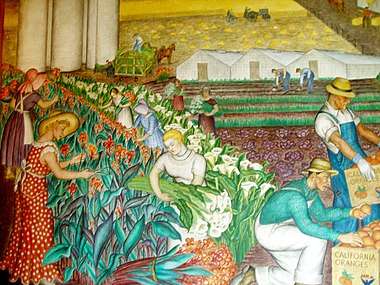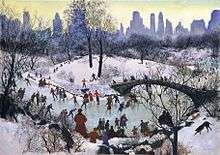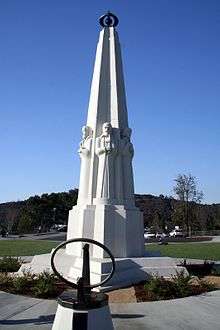Public Works of Art Project
The Public Works of Art Project (PWAP) was a program to employ artists, as part of the New Deal, during the Great Depression. It was the first such program, running from December 1933 to June 1934. It was headed by Edward Bruce, under the United States Treasury Department and paid for by the Civil Works Administration.[1]



Purpose and scope
The purpose of the PWAP was "to give work to artists by arranging to have competent representatives of the profession embellish public buildings."[2] Artists were told that the subject matter had to be related to the "American scene". Artworks from the project were shown or incorporated into a variety of locations, including the White House and House of Representatives.[2][3]
Artists participating in the project were paid wages of $38 – $46.50 per week.[4] Participants were required to be professional artists, and in total, 3,749 artists were hired, and 15,663 works were produced.[3]
The project was succeeded by the Federal Art Project of the Works Progress Administration (WPA).[3]
Coit Tower
The largest of the projects sponsored by the PWAP were the murals in San Francisco’s Coit Tower, employing a total of 44 artists and assistants, begun in December 1933 and completed in June 1934. Many of the muralists were faculty members or former students of the California School of Fine Arts (CSFA). Among the lead artists were Maxine Albro, Victor Arnautoff, Jane Berlandina, Ray Bertrand, Roy Boynton, Ralph Chesse, Ben Cunningham, Rinaldo Cuneo, Mallette Harold Dean, Parker Hall, Edith Hamlin, George Albert Harris, William Hesthal, John Langley Howard, Lucien Labaudt, Gordon Langdon, Jose Moya del Pino, Otis Oldfield, Frederick E. Olmsted, Suzanne Scheuer, Ralph Stackpole, Edward Terada, Frede Vidar, Clifford Wight, and Bernard Zakheim.
After a majority of the murals were completed, the Big Strike of 1934 shut down the Pacific Coast. Though it has been claimed that allusions to the event were subversively included in the murals by some of the artists, in fact the murals were largely completed before the strike began and none of those that were not completed by that time show any reference to the strike.[5]
Griffith Observatory's Astronomers Monument
Another significant project funded by PWAP is the Astronomers Monument at Griffith Observatory in Los Angeles. The monument is a large outdoor concrete sculpture on the front lawn of the Observatory that pays homage to six of the greatest astronomers of all time: Hipparchus (about 150 BC); Nicholas Copernicus (1473–1543); Galileo Galilei (1564–1642); Johannes Kepler (1571–1630); Isaac Newton (1642–1727); and William Herschel (1738–1822). Soon after the PWAP began in December 1933, in cooperation with the Los Angeles Park Commission, PWAP commissioned a sculpture project on the grounds of the new Griffith Observatory (which was under construction). Using a design by local artist Archibald Garner and materials donated by the Women's' Auxiliary of the Los Angeles Chamber of Commerce, Garner and five other artists sculpted and cast the concrete monument and figures. Each artist was responsible for sculpting one astronomer; one of the artists, George Stanley, was also the creator of the famous "Oscar" statuette presented at the Academy Awards. On November 25, 1934, about six months prior to the opening of the Observatory, a celebration took place to mark completion of the Astronomers Monument. The only "signature" on the Astronomers Monument is "PWAP 1934" referring to the program which funded the project and the year it was completed.
Muse of Music, Dance, Drama
.jpg)
This Art Deco style monument serves as the gateway to the Hollywood Bowl, and is said to be the largest of hundreds of monuments in Southern California constructed under the WPA.[6] The 200-foot long, 22-foot high sculpture is also a fountain and was constructed with concrete and covered with slabs of decorative granite.
The structure was completed in 1940 by George Stanley, also a contributor to the Griffith Observatory's Astronomers Monument and who is better known as the sculptor who molded the original Academy Awards' Oscar statue. The structure was refurbished in 2006.[7]
See also
- Federal Art Project, a New Deal federal arts program operated by the Works Progress Administration which ran from 1935 to 1943.
- Section of Painting and Sculpture, a New Deal federal arts program also operated by the United States Department of the Treasury.
- Treasury Relief Art Project
- List of New Deal sculpture
References
- "History of the New Deal Art Projects". wpaMurals.com - New Deal Art During the Great Depression. Retrieved July 29, 2005.
- Brown, Elizabeth. "1934: A New Deal for Artists". Smithsonian American Art Museum. Archived from the original on 18 March 2015. Retrieved 9 October 2013.
- Adler, Jerry. "1934: The Art of the New Deal". Smithsonian Magazine. Retrieved 9 October 2013.
- Mahoney, Eleanor. "The Public Works of Art Project in Washington State". Retrieved 9 October 2013.
- Masha Zakheim, Coit Tower, San Francisco: Its History and Art, 2nd edn., 2009
- "Muse of Music, Dance, Drama | LA County Arts Commission". www.lacountyarts.org. Retrieved 2018-04-27.
- Pool, Bob (2006-06-20). "Getting a Splash From the Past". Los Angeles Times. ISSN 0458-3035. Retrieved 2018-04-27.
Further reading
- Pohl, Frances K. (2008). Framing America. A Social History of American Art. New York: Thames & Hudson. ISBN 978-0-500-28715-6.
- Contreras, Belisario R. (1983). Tradition and Innovation in New Deal Art. London and Toronto: Associated University Presses.
- O'Connor, Francis V., ed. (1973). Art for the Millions: Essays from the 1930s by Artists and Administrators of the WPA Federal Art Project. Boston: New York Graphic Society.
- "1934: A New Deal for Artists" is an exhibition featuring artworks from the Public Works of Art Project at the Smithsonian American Art Museum. This site contains a slide show, public programs, and recent news stories
- Public Works of Art Project, video
External links
| Wikimedia Commons has media related to Public Works of Art Project. |
- The Living New Deal Project, a digital database of the lasting effects of the New Deal founded in the Department of Geography at the University of California, Berkeley (including an interactive map featuring detailed information on public artworks created as a part of the New Deal.
- New Deal Art Registry
- 1934: A New Deal for Artists, a link to Anne Prentice Wagner's article, "1934: A New Deal for Artists" in the Spring 2009 issue of Antiques and Fine Art Magazine.